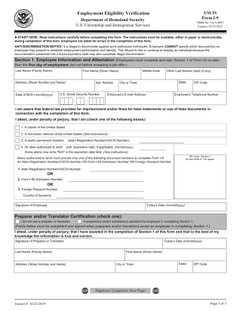MAR 2020, Vol 17, Issue 3
Overview
- New I-9 Form
- OSHA 300A Electronic Submission Deadline
- Update Your AAP’s
- 1095 Form Deadline
- MD Ban the Box
- Interim Guidance to Plan and Respond to Coronavirus Disease 2019 (COVID-19)
New I-9 Form
A new version of the I-9 employment eligibility verification form has been issued. The new version is dated 10/21/2019 but will not become mandatory until May 1, 2020. Through April 30, 2020, employers can choose to use the previous edition dated 07/17/2017 or the new edition. U.S. Citizenship and Immigration Services (USCIS) publishes a paper I-9 Form and an electronic, fillable I-9 Form. The new version of the paper form has no changes from the prior version.
The form is used to verify the identity and employment authorization of individuals hired for employment in the United States. All U.S. employers must properly complete the Form I-9 for each person they hire for employment in the U.S., including both citizens and non-citizens. New hires and employers, or their authorized representatives, must complete the form. Employers must retain the completed forms for one year after termination or three years following hire date, whichever is later and make them available for inspection when called to do so. Please visit www.uscis.gov/i-9 to download the instructions and applicable forms.
- - - -
OSHA 300A Electronic Submission Deadline
Establishments with 250 or more employees that are currently required to keep Occupational Safety and Health Administration (OSHA) injury and illness records, and establishments with 20-249 employees that are classified in certain industries with historically high rates of occupational injuries and illnesses, are required to electronically submit their 300A forms to OSHA by March 2, 2020.
- - - -
Time to Update Your AAP’s
Many Affirmative Action Plans (AAPs) expired on December 31, 2019. Under federal law, government contractors and subcontractors with 50 or more employees who have entered into at least one contract of $50,000 or more with the federal government must prepare and maintain a written affirmative action program, which must be developed within 120 days from the commencement of the contract and must be updated annually.
AAP’s should be submitted to DOL during the first quarter of 2020.
Reminder: Contractors should resurvey their workforces with Voluntary Self-Identification of Disability
The regulations that updated Section 503 of the Rehabilitation Act of 1973 took effect on March 24, 2014. These updates required federal contractors and subcontractors to invite their employees to voluntarily self-identify their status as an individual with a disability using the Office of Federal Contract Compliance Programs’ (OFCCP) official invitation, Form CC-305 and require that contractors resurvey their workforces at least once every five years, as well as issue at least one reminder between invitations.
- - - -
1095 Form Deadline
The deadline for employers to distribute 2019 Forms 1095-C or 1095-B to employees has been extended to March 2, 2019. The paper filing with IRS is 2/28/20 and the electronic filing with IRS is 3/31/20.
By filing Forms 1095-C with the IRS and providing employees with copies, employers with 50 or more full-time or equivalent employees show they offered eligible employees health coverage that was compliant with the Affordable Care Act (ACA). For smaller organizations, Forms 1095-B are filed and distributed by self-insured employers or insurance companies.
- - - -
MD Ban the Box
Effective February 29, 2020 it is unlawful for any employer in the state of Maryland with 15 or more employees to inquire into an applicant's criminal history before the employer conducts its first in-person interview.
- - - -
Interim Guidance to Plan and Respond to Coronavirus Disease 2019 (COVID-19)
The Centers for Disease Control and Prevention (CDC) provides interim guidance based on what is currently known about the Coronavirus Disease 2019 (COVID-19).
Recommended strategies for employers to use now:
Actively encourage sick employees to stay home:
- Employees who have symptoms of acute respiratory illness are recommended to stay home and not come to work until they are free of fever (100.4° F [37.8° C] or greater using an oral thermometer), signs of a fever, and any other symptoms for at least 24 hours, without the use of fever-reducing or other symptom-altering medicines (e.g. cough suppressants). Employees should notify their supervisor and stay home if they are sick.
- Ensure that your sick leave policies are flexible and consistent with public health guidance and that employees are aware of these policies.
- Talk with companies that provide your business with contract or temporary employees about the importance of sick employees staying home and encourage them to develop non-punitive leave policies.
- Do not require a healthcare provider’s note for employees who are sick with acute respiratory illness to validate their illness or to return to work, as healthcare provider offices and medical facilities may be extremely busy and not able to provide such documentation in a timely way.
- Employers should maintain flexible policies that permit employees to stay home to care for a sick family member. Employers should be aware that more employees may need to stay at home to care for sick children or other sick family members than is usual.
Separate sick employees:
- CDC recommends that employees who appear to have acute respiratory illness symptoms (i.e. cough, shortness of breath) upon arrival to work or become sick during the day should be separated from other employees and be sent home immediately. Sick employees should cover their noses and mouths with a tissue when coughing or sneezing (or an elbow or shoulder if no tissue is available).
Emphasize staying home when sick, respiratory etiquette and hand hygiene by all employees:
- Place posters that encourage staying home when sick, cough and sneeze etiquette, and hand hygiene at the entrance to your workplace and in other workplace areas where they are likely to be seen.
- Provide tissues and no-touch disposal receptacles for use by employees.
- Instruct employees to clean their hands often with an alcohol-based hand sanitizer that contains at least 60-95% alcohol or wash their hands with soap and water for at least 20 seconds. Soap and water should be used preferentially if hands are visibly dirty.
- Provide soap and water and alcohol-based hand rubs in the workplace. Ensure that adequate supplies are maintained. Place hand rubs in multiple locations or in conference rooms to encourage hand hygiene.
- Visit the coughing and sneezing etiquette and clean hands webpage for more information.
Perform routine environmental cleaning:
- Routinely clean all frequently touched surfaces in the workplace, such as workstations, countertops, and doorknobs. Use the cleaning agents that are usually used in these areas and follow the directions on the label.
- No additional disinfection beyond routine cleaning is recommended at this time.
- Provide disposable wipes so that commonly used surfaces (for example, doorknobs, keyboards, remote controls, desks) can be wiped down by employees before each use.
- - - -
Contact HR Strategies staff at 302.376.8595 or info@hrstrategies.org if you would like support or would like to learn more about the items in this newsletter.
Find more related articles:
- New I 9 Form
- U S Citizenship And Immigration Services USCIS
- OSHA 300 A Electronic Submission Deadline
- Occupational Safety And Health Administration OSHA
- Update Your AA Ps
- Affirmative Action Plans AA Ps
- Voluntary Self Identification Of Disability
- Office Of Federal Contract Compliance Programs OFCCP
- Form CC 305
- 1095 Form Deadline
- 1095 C
- 1095 B
- Affordable Care Act ACA
- MD Ban The Box
- Interim Guidance To Plan And Respond To Coronavirus Disease 2019 COVID 19
- Centers For Disease Control And Prevention CDC
- Sick Leave Policies
- Non Punitive Leave Policies
- Acute Respiratory Illness Symptoms
- Cough And Sneeze Etiquette


